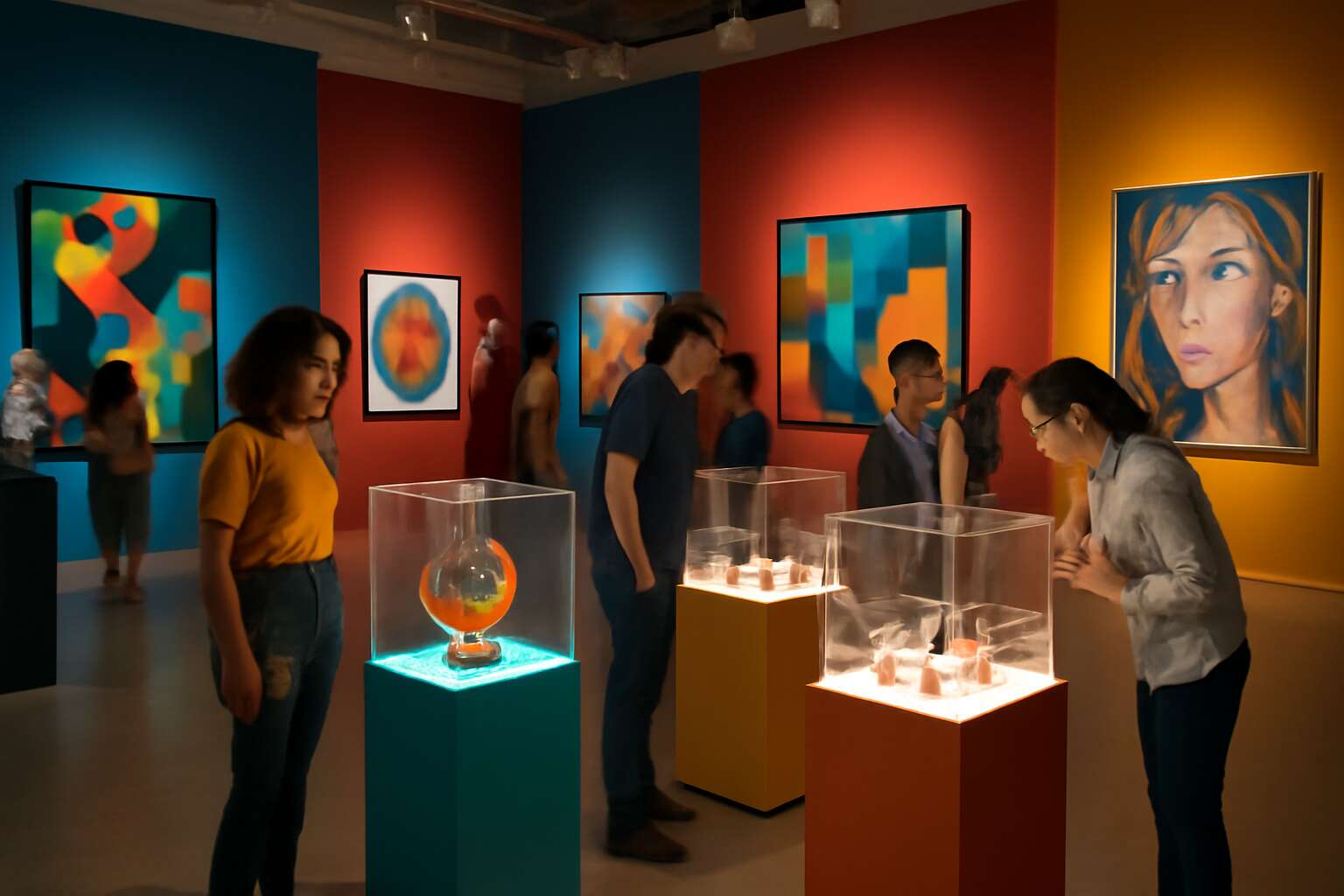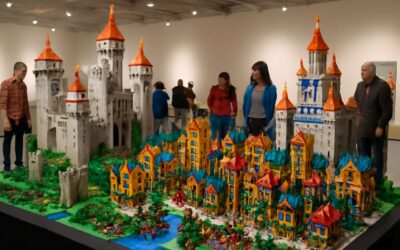Understanding Exhibitions: A Complete Guide
What Is an Exhibition?
Exhibitions are the grand stage of the business and creative worlds—think of them as a bustling marketplace where innovation, art, and commerce collide. In fact, statistics show that over 90% of businesses consider exhibitions crucial for networking and brand visibility. But what exactly is an exhibition? Simply put, it’s a curated event where organisations showcase their products, services, or ideas to a targeted audience. Whether it’s a trade show, art fair, or industry conference, each exhibition serves as a vibrant platform for interaction and discovery.
Understanding the essence of an exhibition goes beyond just displaying items; it’s about creating an experience that captivates attendees. For organisers, it’s a delicate dance of logistics, marketing, and presentation—each element designed to leave a memorable impression. When executed well, an exhibition becomes a catalyst for growth, collaboration, and even a bit of healthy competition. So, whether you’re a first-time exhibitor or a seasoned pro, recognising the core purpose of an exhibition helps unlock its true potential—after all, it’s more than just showcasing, it’s about making meaningful connections that endure beyond the event itself.
Types of Exhibitions – Array
Understanding exhibitions involves recognising the diverse tapestry of formats that serve different industries and artistic expressions. Each type of exhibition is designed to maximise engagement and cater to specific audiences, transforming a simple event into a compelling experience. From the grandeur of large-scale trade shows to intimate gallery displays, the spectrum of exhibitions is as varied as the ideas they showcase.
One of the most prominent types is the trade exhibition, which acts as a marketplace where businesses demonstrate their latest innovations and forge strategic alliances. Art exhibitions, on the other hand, focus on aesthetic storytelling, offering a platform for artists to present their work to a captivated audience. Meanwhile, industry-specific exhibitions, such as technology expos or medical conferences, provide specialised environments for knowledge exchange and networking.
To simplify the diversity within exhibitions, they can be categorised into:
- Trade exhibitions
- Art exhibitions
- Consumer exhibitions
- Industry or professional exhibitions
Each category serves a unique purpose, but all share the common goal of fostering connections, sparking inspiration, and driving growth. By understanding these distinctions, organisers and exhibitors alike can tailor their approach, ensuring every exhibition leaves a lasting impact and unlocks new opportunities for collaboration and innovation.
Purpose and Benefits of Exhibitions – Array
Exhibitions are more than just showcases—they are vibrant crossroads where ideas bloom and connections are forged. According to recent studies, over 90% of businesses see a tangible return on investment from participating in an exhibition, highlighting their undeniable value. These events serve as a powerful platform for sharing innovation, celebrating cultural heritage, and fostering collaborations that can transcend borders.
At their core, exhibitions are designed with purpose: to inspire, educate, and create opportunities. Whether it’s a sprawling trade exhibition that draws industry leaders or an intimate art exhibition that touches the soul, each plays a vital role in shaping communities and industries. The true magic of an exhibition lies in its ability to transform a simple gathering into a compelling experience—where stories are told, ideas are exchanged, and relationships flourish.
Key Elements of a Successful Exhibition – Array
Step into the world of exhibitions, where every detail counts and success hinges on a blend of creativity and precision. Despite their colourful facades, the secret to a truly memorable exhibition lies in understanding the key elements that make it shine. With over 90% of businesses reporting a tangible return on investment, it’s clear that an exhibition isn’t just a pretty picture—it’s a strategic powerhouse.
At the heart of a successful exhibition are components that ensure it captivates and converts. From compelling booth design to seamless logistics, each element must work in harmony. Here’s a quick rundown of the foundational pillars:
- Clear Objectives: Know what you want to achieve—be it brand awareness, lead generation, or industry networking.
- Engaging Visuals: Eye-catching displays and innovative layouts draw visitors in and make your exhibition stand out amidst the crowd.
- Strategic Location: Positioning your booth within the exhibition hall can significantly influence foot traffic and engagement.
- Effective Staffing: Knowledgeable, personable staff can turn curious passersby into loyal clients or partners.
Remember, an exhibition isn’t just about showcasing products or services; it’s about crafting an experience that leaves a lasting impression. Every element, from the smallest detail to the grand design, plays a vital role in transforming a simple gathering into a thriving hub of opportunity.
Planning an Exhibition for Maximum Impact
Setting Clear Objectives
A well-crafted exhibition transforms a fleeting moment into an unforgettable experience. To achieve this, setting clear objectives is paramount—these act as the compass guiding every decision, from layout to content. Without a defined purpose, an exhibition risks losing its impact amidst a sea of competing events.
Understanding your core aims—whether to educate, inspire, or generate leads—allows for a more strategic approach. For example, if the goal is to boost brand awareness, every element should reinforce your message and resonate with your target audience. It’s often helpful to create specific, measurable objectives such as increasing visitor engagement by a certain percentage or securing a set number of new contacts.
To streamline this process, consider employing a straightforward framework like this:
- Identify the primary goal of the exhibition.
- Determine key performance indicators (KPIs).
- Align every aspect of the event to these objectives.
- Review progress and refine strategies accordingly.
When objectives are crystal clear, the exhibition becomes a magnetic showcase that leaves a lasting impression—turning visitors into loyal advocates and your brand into a memorable experience.
Budgeting and Funding
Planning an exhibition with maximum impact requires more than just a flair for the dramatic; it demands a meticulous approach to budgeting and securing funding. After all, even the most dazzling displays can falter without sufficient financial backing. A well-structured budget isn’t merely a list of costs but a strategic blueprint that balances ambition with realism.
Securing funding often involves a blend of sponsorships, grants, and prudent resource allocation. It pays to craft compelling proposals that highlight how your exhibition will offer value—be it through innovative content or unparalleled engagement. When funds are tight, prioritising elements that deliver the greatest return on investment ensures that every penny contributes to the overarching aim of the exhibition.
For organisations looking to streamline funding efforts, consider this approach:
- Identify potential sponsors aligned with your exhibition’s theme
- Develop tiered sponsorship packages to attract diverse support
- Keep meticulous records to track spending and demonstrate value to stakeholders
Ultimately, a carefully curated budget and secured funding transform an ambitious idea into an extraordinary exhibition—one that leaves a lasting impression while honouring your financial boundaries.
Choosing the Right Venue
Choosing the perfect venue can elevate an exhibition from mere presentation to an immersive experience that lingers in the memory. The venue sets the tone, framing the narrative you wish to tell and influencing how audiences interact with your displays. An ideal exhibition space should resonate with the theme, echo the story’s essence, and invite visitors to step into a world of discovery.
Before selecting a location, consider the following crucial factors:
- Accessibility for your target audience
- Capacity to accommodate your displays and visitors comfortably
- Availability of necessary facilities, such as lighting and climate control
Sometimes, the grandeur of a historic hall or a sleek modern gallery can dramatically amplify the impact of an exhibition, offering a backdrop that complements the narrative. The right venue does more than house your displays; it creates an environment where the story of your exhibition unfolds with elegance and purpose. In the end, the venue becomes a silent collaborator in your creative vision—transforming an ordinary space into a portal of inspiration and engagement.
Designing an Effective Layout
Creating an exhibition that leaves a lasting impression demands more than just stunning displays; it requires a masterful plan of layout that guides visitors seamlessly through the narrative. A well-designed exhibition layout is akin to a well-choreographed dance—each step deliberate, each space purposefully curated to evoke curiosity and engagement.
When planning your exhibition, consider the flow of traffic. An intuitive arrangement—perhaps with thematic zones or chronological sequences—can transform a simple visit into an immersive journey. To optimise impact, think about the placement of key pieces, ensuring they command attention without overwhelming the space. Incorporating varied display heights and interactive elements encourages visitors to explore actively rather than passively.
Sometimes, an exhibition benefits from a touch of serendipity. For example, an open-plan layout with designated alcoves can evoke intimacy or grandeur, depending on the story you wish to tell. Remember, the goal is to craft an environment where the visitors feel invited to linger, ponder, and return—turning your exhibition into a memorable dialogue between art and audience.
Selecting Exhibitors and Partners
Securing the right exhibitors and partners can turn an ordinary exhibition into an extraordinary spectacle — or a tepid gathering of curious browsers. With over 80% of successful exhibitions credited to strategic collaborations, it’s clear that choosing the right stakeholders is no mere afterthought. A well-curated exhibition doesn’t just showcase artefacts or products; it weaves a compelling narrative that resonates long after the curtains close.
When selecting exhibitors, look beyond their credentials and consider their synergy with your overarching theme. Think of it as matchmaking, but for brands, artists, or organisations — each should elevate the exhibition’s story rather than overshadow it. Similarly, partnering with aligned sponsors or media outlets can amplify your event’s reach, transforming a local exhibition into a regional or even international phenomenon.
- Identify potential partners whose values and target audiences align with your vision.
- Evaluate their previous collaborations for professionalism and innovation.
- Negotiate mutually beneficial terms that ensure visibility and engagement.
Remember, the true power of an exhibition lies in its ability to captivate and connect. Selecting the right exhibitors and partners isn’t just about filling space; it’s about crafting an immersive experience that turns casual visitors into dedicated fans. After all, an exhibition’s success isn’t measured solely by footfall but by the lasting impression it leaves in the minds of its audience.
Creating Promotional Materials
Creating promotional materials that truly resonate is the heartbeat of a memorable exhibition. In an environment where competition is fierce, your promotional strategy must be both strategic and intriguing. Think beyond generic flyers and standard banners—craft visuals and messaging that evoke curiosity and invite exploration. From visually compelling posters to engaging digital campaigns, every element should serve as an ambassador for the exhibition’s core narrative.
To maximise impact, consider tailoring your promotional materials to reach your target audience effectively. Incorporate storytelling elements that hint at the exhibition’s unique offerings, fostering anticipation and excitement. Utilizing a mix of traditional and digital channels—social media, press releases, and email marketing—ensures your message reaches diverse demographics. Remember, the key to a successful exhibition promotion lies in consistency and creativity, turning passive viewers into eager visitors ready to uncover what lies within.
Strategic positioning and eye-catching design are crucial, but never forget the power of compelling copy. Well-crafted headlines and concise descriptions can make the difference between a pass-by and a full-house event. When executed with precision, your promotional materials become the silent ambassadors of your exhibition, building anticipation long before the doors open and leaving a lasting impression long after the final curtain.
Utilizing Digital Marketing Tools
In an era where attention spans diminish faster than shooting stars, harnessing the power of digital marketing tools can transform an ordinary exhibition into an extraordinary event. Imagine your exhibition as a captivating story, waiting to be unveiled across multiple digital channels, each one whispering hints of the treasures within. With strategic utilisation of social media, email marketing, and targeted online advertising, your message can reach the right audience at precisely the right moment.
To maximise this digital allure, consider crafting an integrated campaign that includes:
- Compelling social media teasers that tease the exhibition’s highlights
- Engaging email newsletters that build anticipation and offer exclusive previews
- Interactive digital content that invites participation and sharing
By weaving these elements into a cohesive tapestry, your exhibition can transcend physical boundaries and resonate deeply within the digital realm. The magic lies in synchronising your messaging with the natural rhythms of your target audience, turning curious onlookers into eager visitors ready for discovery. When executed with finesse, digital marketing tools become the silent yet potent ambassadors of your exhibition’s enchanting allure.
Marketing Strategies for Exhibition Success
Pre-Event Promotion – Array
In the shadowed corridors of commerce, the true power of an exhibition lies in the art of pre-event promotion. It is the unseen hand guiding curious visitors through the labyrinth, whispering promises of discovery and innovation. An effective marketing strategy transforms anticipation into a magnetic pull, drawing the right audience into the waiting embrace of your exhibition.
Harness digital marketing tools—social media, email campaigns, and targeted advertisements—to craft a compelling narrative that resonates with potential attendees. Engaging content, such as behind-the-scenes glimpses or exclusive previews, stirs intrigue and builds momentum. Consider implementing a countdown to heighten excitement, or leveraging influencer partnerships to cast a wider net.
Remember, the key to exhibition success is not just visibility, but creating an aura of mystery that beckons visitors to step into the unknown. As the shadows lengthen before the event, your marketing efforts should cast a long, captivating spell over your audience.
On-Site Engagement – Array
On-site engagement transforms an ordinary exhibition into an immersive experience that lingers in visitors’ minds long after they leave. It’s the moment when curiosity is piqued, and wonder sparks into genuine interaction. To foster this, consider integrating interactive displays, live demonstrations, or VR experiences that captivate the senses and encourage participation.
Creating a seamless flow within the exhibition space is crucial—people should feel drawn naturally from one exhibit to the next, guided by strategic placement and compelling signage. Incorporating engaging activities such as guided tours or Q&A sessions can deepen visitor involvement and transform passive observation into active discovery.
A well-orchestrated on-site engagement strategy doesn’t just enhance visitor satisfaction; it amplifies the overall impact of the exhibition. When visitors become part of the narrative, the exhibition’s message resonates more profoundly, leaving an indelible impression. This dynamic approach ensures your exhibition stands out amidst a sea of events, captivating audiences and elevating your brand’s presence.
Post-Event Follow-Up – Array
Post-event follow-up is the secret sauce that transforms a fleeting exhibition experience into a long-lasting brand impression. With a staggering 80% of exhibitors reporting that their post-event interactions significantly influence future business, it’s clear that what happens after the exhibition is just as vital as what occurs during.
Engaging attendees after the event can take many forms, from personalised emails and exclusive offers to sharing behind-the-scenes content. Incorporating a structured plan, such as a dedicated follow-up campaign, ensures no lead slips through the cracks.
Consider implementing a simple yet effective approach:
- Send personalised thank-you messages to visitors and prospects.
- Share valuable content or exclusive previews based on their interests.
- Invite feedback to improve future exhibitions and show your commitment to continuous improvement.
Remember, the goal of post-event engagement isn’t just to close deals; it’s about cultivating genuine relationships that turn one-time visitors into loyal advocates. An intelligently crafted post-exhibition follow-up strategy is the final piece of the puzzle—magnifying your exhibition’s success and ensuring your brand stays top of mind long after the lights go out.
Enhancing Visitor Experience at Exhibitions
Creating an Inviting Atmosphere
Creating an inviting atmosphere at an exhibition transforms a mere gathering into a memorable voyage through wonder and discovery. When visitors step into a space that feels warm, engaging, and thoughtfully curated, they are naturally drawn deeper into the narrative woven by the exhibitor. Lighting that mimics the gentle glow of dawn, ambient sounds reminiscent of distant markets, and tactile elements inviting touch all serve to craft an immersive environment.
To truly enhance visitor experience, consider integrating sensory-rich elements that evoke emotion and curiosity. For instance, a carefully curated scent can evoke nostalgia or excitement, subtly guiding visitors through the exhibition’s story. Incorporating interactive features—such as touch screens, augmented reality, or live demonstrations—can also elevate engagement.
A well-designed exhibition space should facilitate effortless movement, guiding visitors along a natural flow. This can be achieved through strategic placement of exhibits, clear signage, and inviting seating areas. By prioritising these aspects, an exhibition becomes not just a showcase, but a captivating journey that leaves a lasting impression.
Utilizing Technology – Array
In an era where digital innovation shapes every facet of our lives, leveraging technology to enhance the visitor experience at an exhibition has become more vital than ever. Interactive displays and augmented reality (AR) can transform a static exhibit into a dynamic journey, captivating audiences and fostering a deeper emotional connection. Imagine walking through an exhibition where virtual elements seamlessly blend with physical artefacts, inviting visitors to explore stories from multiple perspectives. Such immersive experiences not only elevate engagement but also create memorable moments that linger long after the event ends.
Utilising digital tools such as touch screens, virtual tours, and real-time feedback stations can significantly enrich the exhibition environment. These features encourage active participation and cater to diverse learning styles, making the visit both educational and emotionally resonant. Incorporating QR codes and mobile apps allows visitors to access additional content effortlessly, turning each step into an unfolding narrative. When thoughtfully integrated, technology transforms an exhibition from a simple showcase into a captivating voyage of discovery that leaves a lasting impression.
Providing Informative and Engaging Content
Creating an exhibition that resonates long after the lights go down hinges on delivering truly engaging and informative content. Visitors crave more than just visual appeal; they seek stories that stir their imagination and deepen their understanding. Immersive narratives, compelling visuals, and strategic storytelling turn a static display into a vibrant experience that sparks curiosity and emotional investment.
To elevate the visitor experience, consider integrating elements that cater to diverse learning styles. Interactive components such as touchscreens, augmented reality (AR), and multimedia presentations invite visitors to explore content at their own pace. These tools transform the traditional exhibition into an active learning environment, fostering a sense of discovery and connection.
Incorporating clear, accessible information—whether through concise labels, engaging audio guides, or digital apps—ensures that each visitor can delve into the exhibition’s depths comfortably. By weaving content into a seamless narrative, the exhibition becomes a voyage that captivates, educates, and inspires. When executed with finesse, this approach not only enhances the overall experience but also cements the exhibition’s place in visitors’ memories for years to come.
Inclusive and Accessible Design
Creating an inclusive and accessible exhibition isn’t just a moral imperative—it’s a strategic advantage that elevates the entire visitor experience. When designed thoughtfully, an exhibition becomes a welcoming space where diverse audiences feel seen, heard, and engaged. Incorporating features like ramps, tactile displays, and clear signage ensures that everyone, regardless of ability, can explore and connect with the content.
To truly enhance accessibility, consider integrating multimedia tools that cater to different learning styles. For instance, audio descriptions for visual displays or subtitles for videos can make a significant difference. An engaging exhibition seamlessly blends these elements, transforming passive observation into active discovery. Remember, an exhibition that values inclusivity ignites curiosity and fosters deeper emotional bonds—making it unforgettable for all visitors.
- Accessible pathways and seating arrangements
- Multisensory content for varied learning preferences
- Clear, large-font signage and universal symbols
Gathering Visitor Feedback
Gathering visitor feedback is an invaluable step in enhancing the overall experience at any exhibition. It transforms a static event into a dynamic dialogue, allowing organisers to understand what truly resonates with attendees. By implementing simple yet effective methods—such as comment cards, digital surveys, or interactive kiosks—organisers can capture genuine insights that guide future improvements.
Listening to visitors’ voices not only refines the exhibition layout and content but also fosters a sense of community and trust. Incorporating this feedback into subsequent exhibitions ensures that each event becomes more engaging, inclusive, and memorable. After all, an exhibition that evolves based on visitor input demonstrates a genuine commitment to creating a space where everyone feels valued and inspired.
Measuring Exhibition Success and ROI
Key Performance Indicators (KPIs) – Array
Measuring the success of an exhibition is akin to capturing the elusive shimmer of a mirage—difficult but utterly essential. To truly gauge the impact, organisations turn to Key Performance Indicators (KPIs) that illuminate the path to understanding visitor engagement, lead generation, and brand visibility. These metrics serve as the compass guiding future exhibition strategies, ensuring every endeavour is more enchanting than the last.
A deep dive into ROI (Return on Investment) reveals that beyond immediate sales, the true value of an exhibition lies in the relationships forged and brand awareness cultivated. Popular KPIs include visitor footfall, engagement levels, and post-event conversions, each telling a story of growth and opportunity.
In essence, an exhibition’s success isn’t just measured by numbers but by the vivid tapestry of connections and impressions it leaves behind. As one expert astutely remarks, “The real magic of an exhibition is in the memories it creates and the doors it opens.”
Analyzing Feedback and Data
Measuring the true impact of an exhibition transcends mere attendance figures; it is an artful endeavour, akin to capturing a fleeting shadow in the twilight. The secret lies in analysing the delicate dance of feedback and data, revealing stories that numbers alone cannot tell. When organisations delve into visitor insights, they unearth a treasure trove of behaviours, preferences, and emerging trends, forging a clearer path to future success.
By examining metrics such as engagement levels, lead quality, and post-event conversions, the exhibition’s narrative becomes more vivid. A nuanced understanding of these elements transforms raw data into strategic gold, illuminating which aspects resonate most deeply with attendees. This process is not merely about tallying figures but about interpreting the subtle symphony of impressions and connections that define an exhibition’s resonance in the minds of visitors.
- Gather comprehensive visitor feedback through surveys and interactive digital tools.
- Analyse engagement metrics to identify high-traffic zones and popular content.
- Track lead conversion rates to measure real-world impact beyond the event.
Ultimately, the ROI of an exhibition extends beyond immediate sales; it is reflected in the cultivation of relationships, brand visibility, and the intangible magic that lingers long after the closing curtain. When data and feedback harmonise, they forge a compelling narrative of growth and opportunity—transforming fleeting moments into enduring memories that open new doors of possibility.
Reporting and Continuous Improvement
Measuring the true success of an exhibition is an endeavour shrouded in shadows and subtlety. Beyond mere attendance figures, it is about peeling back the layers of perception to unveil the hidden stories etched into visitor behaviour and engagement. When organisations harness the power of detailed ROI reporting, they begin to see an intricate tapestry woven from data points—each one whispering secrets about what truly resonates.
A vital aspect of this process is tracking key performance indicators (KPIs) such as lead quality, conversion rates, and post-event interactions. These metrics act as lanterns illuminating the path from fleeting moments of intrigue to lasting relationships. By analysing these facets, one can discern which elements cast a more potent spell upon visitors, transforming raw data into a narrative of growth and opportunity.
In the realm of exhibition management, continuous improvement is the silent, ever-present spectre that guides evolution. Employing a blend of qualitative feedback and quantitative metrics, organisers can refine their craft with each iteration. This relentless pursuit of excellence ensures that every exhibition becomes not just an event, but an experience etched into the memory of every attendee—a testament to the artful dance between strategy and serendipity.




0 Comments